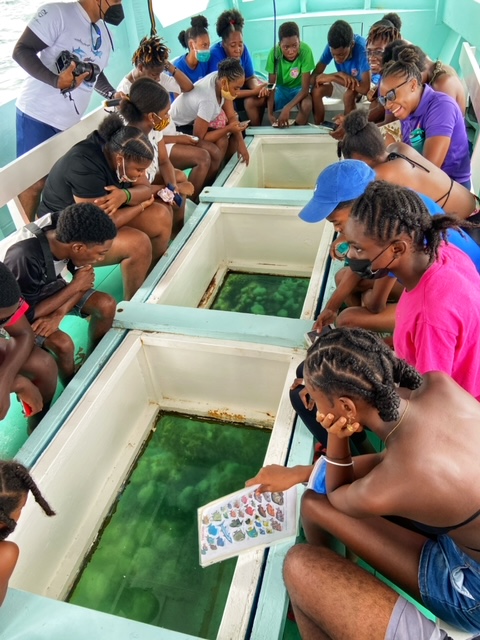Our Ocean Backyard in Buccoo
Twenty youths and their caregivers were treated to a tour of the Buccoo Reef Marine Protected Area by SpeSeas in honour of World Ocean Day. Pat Ganase reports.
The observance of World Ocean Day provides the opportunity to celebrate and learn about the most vital ecosystem on our planet, the ocean. Ocean makes up 70 % of the planet and hosts about 50 – 80 % of all life. Some 133 countries and over three billion people rely on the ocean for food, livelihoods, as well as a source of recreation and cultural significance. More importantly our ocean is the regulator of climate, as it absorbs 93 % of the planet’s heat and 25 % of carbon dioxide emissions and generates 50 % of the planet’s oxygen. Unfortunately, the ocean and marine ecosystems are exposed to pollution and mismanagement, especially the high seas beyond national jurisdictions. About 90 % of all big fish have been overexploited and large sections of the ocean have become heavily polluted and degraded, even anoxic (lacking oxygen) and tolerable only by microbes.
Island nations, like Trinidad and Tobago, have a lot to be thankful for with respect to the resources provided by our wetlands and marine ecosystems. However, while our economic exclusion zone is fifteen times our combined land mass, most citizens are ignorant about the marine world that cradles Trinidad and Tobago. Many of us do not understand how we are children of the ocean and beneficiaries of this vast resource. Even fewer have the opportunity to see the marine world below and observe the marine ecosystems as places of rich beauty and biodiversity. In Tobago, the ocean is at our doorstep. Tobagonians have the privilege that only 4 % of the world’s population (275 million people) has: living within 30 km of a coral reef. This is a privilege that many spend thousands of dollars to experience.
Charity begins at home. In World Ocean Week 2022, it
was timely for representatives of the Yahweh Foundation located in Buccoo, and
the Police Youth Clubs of Mason Hall, Plymouth and Signal Hill to be hosted on
an excursion to the Buccoo Reef Marine Protected Area, Bon Accord Lagoon and
mangrove ecosystem. This tour was organized by SpeSeas, an NGO of marine
scientists and educators dedicated to raising awareness of the marine
ecosystems that Trinbagonians benefit from and the plights they face.

Peering through the glass into the
marine world. Photo by Anjani Ganase
The group of young persons gathered in Store Bay. They were met by the SpeSeas Team – directors, members and volunteers - who introduced them to the underwater world with virtual dives on coral reefs of Tobago using virtual reality (VR) headsets. This collection – The Maritime Ocean Collection – is available online for virtual viewing. Many were astounded that these were reefs of Tobago and included the reefs adjacent to the communities they grew up in Buccoo, Plymouth, Mt Irvine, Speyside.
Attendees from Yahweh Foundation. Photo by
Anjani Ganase
They travelled to the Buccoo Marine Park on the Miss Ayana; the glass bottomed boat owned by Dexter Black. He was the first tour guide of the glass bottomed fleet to receive Blue Flag Certification. This certification is for tour operators with an environmental education focus and high safety standard. Mr. Black highlighted the importance of allowing young people to experience the ocean to broaden their horizon; and promoted the role of young persons as stewards of vulnerable ecosystems. He and his boat captain have been taking people out to the reef since 1988.
The group on board Miss Ayana were treated to unique views of the coastline past Pigeon Point. The sea was calm and all was quiet at nine in the morning. The first thing to come into view through the glass bottom was the expanded field of seagrass in the lagoon. Often confused with algae, the record was set straight by Kelly Mannette, member of SpeSeas and educator on Tobago’s marine environment. Seagrasses are flowering plants that serve as an important habitat for creatures such as lobsters, conch and even the upside-down jellyfish (Cassiopeia species) and provides the major food source for green turtles. The students excitedly looked over the sides of the boat in search of turtles bobbing at the surface for a breath.
 |
| Kelly Mannette, associate member, showing the
different types of vegetation along the Bon Accord Lagoon. Photo by Anjani
Ganase
|
The Buccoo Reef Marine Protected Area is fed by and extends to the Bon Accord Lagoon and mangrove forest. After lunch, the group took a stroll through the mangrove edge of Buccoo Bay to experience and enjoy the precious wetland that surrounds the Lagoon and connects to the reef. The mangroves are important nurseries for marine organisms; they also provide shelter for nests and roosts for resident and visiting birds. The mangrove forests and marshlands support rich and diverse vegetation that were pointed out. They encountered reeds in marshy areas, buttonwood trees at the start of the walk. As they moved closer to the sea, they could observe the transition of the different mangrove species, from white to black and red: easy to remember like the flag of our country. The tour ended in a moment of silence to listen to the sounds of the birds not seen but heard in the forest by the sea.
Listening to birds in the mangrove forest.
Photo by Anjani Ganase




